Jul 28, 2005
IPod induces allucinations?
Via Mind Hacks
Psychiatrist Victor Aziz has suggested that some iPod users are experiencing musical hallucinations owing to the constant repetition of favourite songs.
Dr Aziz was recently featured in a New York Times article discussing musical hallucinations. This story was touted as 'brain becomes an iPod' because musical hallucinations can take the form of complete songs or melodies.
 In an interesting twist, however, Aziz suggests the use of personal music players may lead to musical hallucinations in some people.
In an interesting twist, however, Aziz suggests the use of personal music players may lead to musical hallucinations in some people.
This is not as far fetched as it sounds. A recent brain scanning study used a technique where songs were silenced for short intervals when played, and showed that the auditory cortex remained active when people continued 'hearing' the silenced tune.
The constant repetition of the same music may produce a similar effect, perhaps leading to the hallucinations.
In July's issue of the International Journal of Geriatric Psychiatry Aziz and colleague Nick Warner reviewed 30 cases of musical hallucinations in older people and found the hallucinations could be very specific and distinct:
The hymn 'Abide with me' was clearly the most frequent music heard. In 2/3 of cases religious music predominated, with Christmas music also common. In most cases the music took the form of solo voice (male or female) with instrumental backing. Two people could identify the singer (George Formby and Luciano Pavarotti).
16:45 | Permalink | Comments (0) | Tags: Positive Technology
Jul 27, 2005
Workshop on Personalisation for e-Health
Via Psychnology
Workshop on Personalisation for e-Health to be held in conjunction with UM 2005 Edinburgh, UK, July 2005
The past years have witnessed unprecedented levels of investment in the e-Health sector, both in terms of research effort, and in terms of funding, as well as a great public interest. e-Health can be broadly defined as the application of IT (especially Internet technologies) to improve the access, efficiency, effectiveness and quality of any processes (clinical and business alike) related to health care. In the e-Health vision, intelligent systems would, for example, enable:
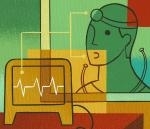 - citizens to take more control of their well-being, by accessing personalised and qualified health information, both medical and pedagogical, and accessing appropriate medical care from their homes;
- citizens to take more control of their well-being, by accessing personalised and qualified health information, both medical and pedagogical, and accessing appropriate medical care from their homes;
- health professionals to manage their activity more efficiently, by receiving relevant and timely updates; and
- teams of health professionals to work together more effectively, coordinating their activities, sharing their knowledge about the patients they are collectively taking care of, and ensuring the best coordinated care is provided.
17:35 Posted in Positive Technology events | Permalink | Comments (0) | Tags: Positive Technology
CHI 2005 - Student Design Competition Results
Via CHI 2005 web site
Computer Human Interaction 2005 Student Design Competition challenged students to design a tool, application or service for elder companionship. The winning team was mPath (Shweta Aneja, Kevin Makice, Apurva Pangam, Matt Weldon, Indiana University, USA). mPath works with administrators of assisted-living facilities to oversee an ad-hoc volunteer network. Interacting with residents, these volunteers assess social relationships and emotional reactions, quantifying for the computer their qualitative observations. In turn, the system examines data over time to isolate anomalies, highlight trends and anticipate future responses. Administrators act upon that information. The overall effect is to increase the social well being of seniors in an unobtrusive manner.
17:15 Posted in Positive Technology events | Permalink | Comments (0) | Tags: Positive Technology
Ambient Experience for children undergoing MRI scan
Via Near Near Future
Ambient Experience for Healthcare is a program designed to lessen patient anxiety and claustrophobic effects of an MRI scan through the use of a multimedia environment. As soon as patients enter the MRI department, they are automatically identified by the system and the environment changes to match their personal features. Lighting and ambience of the room, as well as music and projections, can be adapted to match the specific needs of patients.

Patients can choose from four themes, each geared for different tastes and age groups; aquatic, space, fly-through and a default lava lamp type ambience. RFID-encoded cards corresponding to the theme chosen by patients cause the lighting and wall/ceiling projection to change in the exam room as they enter.
Ambient Experience was recently awarded a gold medal in the annual Industrial Design Excellence Award
10:45 Posted in Pervasive computing | Permalink | Comments (0) | Tags: Positive Technology, Ambient intelligence
Jul 26, 2005
Faculty psychologist job position at Emory using VR
Via VRPsych list
Faculty Psychologist - Emory University School of Medicine, Department of Psychiatry and Behavioral Sciences announces a full time assistant professor position. Job duties include working on an NIMH-funded study exploring medication and virtual reality exposure therapy, administering CBT, program development, and supervision. Requirements: doctoral degree, APA approved internship, CBT experience, supervised postdoctoral year, and Georgia licensed or license eligible.
Application deadline 9/1/05 or until filled.
Send CV, letter of interest, publications, and 4 letters of recommendation to Barbara O. Rothbaum, Ph.D., ABPP, Psychiatry, The Emory Clinic, 1365 Clifton Rd, Atlanta, GA 30322.
17:10 Posted in Research institutions & funding opportunities | Permalink | Comments (0) | Tags: Positive Technology, research tools
Jul 25, 2005
Affective computing in healthcare: the project Myself
The EU-funded project Myself focuses on the enrichment of the simulations and the affective computing methodologies traditionally carried out in didactic classroom.
The project's idea is to integrate affective computing into virtual tutors to enhance distance learning and training applications. Affective computing is aimed at giving computers skills of emotional intelligence, including the ability to recognize and express emotions, and to respond to them effectively.
Started in Semptember 2004 and running 24 months, the project gathers industries and research performers from seven European countries (Italy, Spain, United Kingdom, Estonia, Switzerland, Poland, Holland). The project's coordinator is ACSE, an Italian company that supplies information technology services.
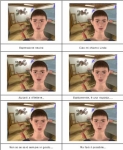 We have interviewed Dr. Fabrizia Mantovani, psychologist, who is working on the research workpackage on Affective Computing for the Center for Studies in Communication Sciences of University Milano-Bicocca, headed by Prof. Luigi Anolli.
We have interviewed Dr. Fabrizia Mantovani, psychologist, who is working on the research workpackage on Affective Computing for the Center for Studies in Communication Sciences of University Milano-Bicocca, headed by Prof. Luigi Anolli.
PTJ - Dr. Mantovani, what are the potential applications of Myself project?
The target application of the project was the development of an e-learning platform endowed with affective computing capabilities (recognition of, and adaptation to, the emotional and motivational states of the users during the learning path). The second objective is development of interactive simulations for the training of communication and emotional skills in professional relationships. In this project, two main target-end users are finance and banking and healthcare professionals.
PTJ - Interesting. But how this approach can be used in healthcare?
The idea is to use 3D-agents based simulations to train physicians and caregivers on how to improve the relationships with patients and their families. Traditionally, soft-skill training is mainly carried out in classroom and face-to-face settings. In Myself, the goal is to use experiential e-learning training to support the acquisition of complex communication and procedural skills (i.e. how to deliver bad health news to the patient, enhance compliance, to be in trust in the relationship etc.), which are useful to improve the relationship between doctors and patients.
More to explore
Affective Computing Portal - a web site devoted to affective computing research
Affective Computing Lab at MIT Medialab - web site of the lab headed by Rosalind Picard
Virtual Reality Lab (VRlab) at the Swiss Federal Institute of Technology - the leading lab for virtual humans research
12:00 Posted in Emotional computing | Permalink | Comments (0) | Tags: Positive Technology, experience computing
Jul 24, 2005
Siggraph 2005
The 32th Conference on Computer Graphics and Interactive Techniques Siggraph 2005 will be held in Los Angeles, 21 July - 4 August. This year advanced program can be downloaded here.
Unfortunately this year I am not going to attend the conference, but if I would, I could not miss Emerging Technologies. The event, hosted by the Siggraph Conference, presents work from many sub-disciplines of interactive techniques, with a special emphasis on projects that explore science, high-resolution digital-cinema technologies, and interactive art-science narrative.
An ET application I would love to see is Haptic Video, presented by Satoshi Saga and colleagues from Tachi Laboratory, The University of Tokyo. Haptic Video allows to transmit physical operations with the same precision, they say, as language.  "In the recording phase", explain Saga, "position and applied force are recorded as the expert works. This information is transformed into position and impedance information, and archived in a database that can be dynamically interpolated. In the presentation phase, the impedance information is presented to the trainee along the trajectory direction, and virtual fixtures, which are like walls with elasticity, are presented orthogonal to the trajectory direction at the same time. As a result, the trainee tries to cancel the force that the expert exerted, and duplicate the desired force proactively"
"In the recording phase", explain Saga, "position and applied force are recorded as the expert works. This information is transformed into position and impedance information, and archived in a database that can be dynamically interpolated. In the presentation phase, the impedance information is presented to the trainee along the trajectory direction, and virtual fixtures, which are like walls with elasticity, are presented orthogonal to the trajectory direction at the same time. As a result, the trainee tries to cancel the force that the expert exerted, and duplicate the desired force proactively"
According to the researchers, Haptic Video demonstrates how humans can use technology to improve their skills in a wide variety of professional and aesthetic fields, from medicine to calligraphy to etiquette.
I also believe that Haptic Video meets all the requirements of a Positive Technology. I foresee applications of this new technology in the field of healthcare, i.e. in distance rehabilitation and telemedicine.
So good luck to Haptic Video
20:20 Posted in Positive Technology events | Permalink | Comments (0) | Tags: Positive Technology
Jul 22, 2005
Mixed and Augmented Reality Conference
The 4th IEEE and ACM International Symposium on Mixed and Augmented Reality (ISMAR 05) will be held from October 5-8, 2005, in Vienna, Austria. Sponsored by IEEE Computer Society and the Österreichische Akademie der Wissenschaften, the conference covers latest developments in the fields of augmented and virtual reality. Over the last decade, these technologies have evolved from experimental technologies to mainstream research activities that are starting to show impact on industry and society. By their very nature, Mixed Reality and Augmented Reality are highly interdisciplinary fields involving signal processing, computer vision, computer graphics, user interfaces, human factors, wearable computing, mobile computing, computer networks, distributed computing, information access, information visualization, and hardware design for new displays and sensors.
16:38 Posted in Positive Technology events | Permalink | Comments (0) | Tags: Positive Technology
Smart brace to prevent falls in the elderly
Via Medgadget and Near Near Future
Stanford entrepreneurs are testing a "smart" brace to prevent falls in the elderly. The tool is fitted with a tiny chip, which continuously monitors the position of the ankle. If the chip detects a roll that is greater than normal, it begins to vibrate. 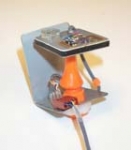
The vibrations send a signal to the brain that the person needs to change the position of their foot or shift their balance in order to avoid a fall.
More to explore:
12:25 Posted in Brain training & cognitive enhancement | Permalink | Comments (0) | Tags: Positive Technology, Cognitive prosthetics
Jul 21, 2005
Ubiquitous computing for cognitive decline
Cognitive decline is one of the most taxing health problems in terms of both its relation to elders' overall functioning and the cost of care. The loss of their abilities to use everything from a coffee maker to a computer may lead to social isolation, a decreased motivation, and increasing dependence on skilled support for assistance in routine activities. Prevention, early detection, and assistance for cognitive decline may be a useful application for ubiquitous computing technologies.
Ubicomp solutions typically involve multiple invisible devices embedded in the physical environment, all connected together to respond in transparent ways to the users in the context of everyday events. Ubicomp may match the challenge of providing elders pervasive support throughout the home, and adaptable levels of support.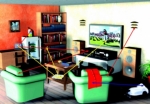
For example, Intel's Proactive Health Research initiative is exploring location and activity tracking technologies to support elders' indipendence and safety monitoring by caregivers. The programme also aims at investigating technologies that facilitate social connectedness and continuation of meaningful activities.
More to explore
Free full-text publications on pervasive computing
16:05 Posted in Pervasive computing | Permalink | Comments (0) | Tags: Positive Technology, Ambient intelligence
VR is going to be cheap
Virtual Reality Therapy (VRT) offers treatment using simulated real life experience provided in a confidential setting. VRT has shown its effectiveness in several common phobias, including claustrophobia, fear of heights, fear of spiders, fear of driving, fear of flying, and fear of public speaking. As a person goes through the VR program, the therapist teaches the client relaxation techniques to deal with the symptoms provoked by exposure to the virtual environment.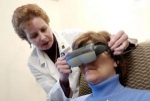
However, until recently, the use of VRT was severely limited by the lack of inexpensive immersive equipment. This opportunity could come along in the fourth quarter of this year, when 3001AD, a company that builds high-end VR machines for large-scale entertainment centers, will introduce a headset that can be used in combination with the Xbox and the Playstation game consoles and several blockbuster game titles.  The system, called "Trimersion" and recently demonstrated at the E3 trade show, promises 360-degree head tracking, uses a binocular video subsystem and delivers a QVGA resolution (320 x 240). Mark Rifkin, senior vice president of 3001 AD suggested retail pricing to come in just under $500.
The system, called "Trimersion" and recently demonstrated at the E3 trade show, promises 360-degree head tracking, uses a binocular video subsystem and delivers a QVGA resolution (320 x 240). Mark Rifkin, senior vice president of 3001 AD suggested retail pricing to come in just under $500.
More to explore:
Cybertherapy.info the reference site for VR therapy
Virtual reality in behavioral neuroscience and beyond, Nature Neuroscience, 1089-1092, Oct. 2002
Virtual Reality Therapy, Harvard Mental Health Letter, on-line, April 2003
Fake worlds offer real medicine, Journal of the American Medical Association, 290 (10), 2107-2109, 22/29 Oct 2003
15:15 Posted in Cybertherapy | Permalink | Comments (0) | Tags: Positive Technology, virtual reality
Jul 19, 2005
The Fifth International Conference on Gerontechnology
The fifth international conference on Gerontechnology took place in Nagoya May 24-27 2005. The slogan of the conference was "Technology for smart aging - For a long and happy life with health and self-esteem". The conference program included sessions like Universal Design, Mobility, Home care and Living, Health care and Robotics for Human Support. Topics like Work and Leisure were also treated.
Use of new information technology (IT) solutions was taken up in most of the presentations. The goal could be to provide elderly people with information about preventive care, help them get useful information when moving around outdoors or handling activities of daily living. It was shown that IT and Assistive Technology (AT) could be used to counteract the triggering factors that normally result in hospitalisation and long time care.
The Design for All and Inclusive design approaches were constantly referred to because it was shown that the elderly people had to be able to use new technology and services themselves. Use of Design for All or Inclusive design strategies and methods ensure that mainstream products, services and environments are accessible to the largest number of people.
Organiser of the conference was the International Society for Gerontechnology ISG.
More to explore:
Links to the conference abstracts:sts.bwk.tue.nl/gerontech/Full_text/Volume_3/nr_4/Contents...
12:32 Posted in Positive Technology events | Permalink | Comments (0) | Tags: Positive Technology
Vagus Nerve Stimulation System for Severe Depression
Via Medgadget
The Food and Drug Administration has recently approved a new treatment for severe depression based on a nerve stimulation system that delivers tiny electric shocks through vagus nerve and into a region of the brain thought to play a role in mood.
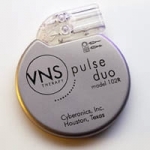 Cyberonics Inc.'s stimulation system is an adjunctive long-term treatment of chronic or recurrent depression for adults who are experiencing a major depressive episode that has not had an adequate response to two or more adequate antidepressant treatments.
Cyberonics Inc.'s stimulation system is an adjunctive long-term treatment of chronic or recurrent depression for adults who are experiencing a major depressive episode that has not had an adequate response to two or more adequate antidepressant treatments.
Despite controversy over whether it's really been proven to work, the potential treatment targets an estimated 4 million Americans with hard-to-treat depression.
12:00 Posted in Brain-computer interface | Permalink | Comments (0) | Tags: Positive Technology, brain-computer interface
Wearable technology promotes the well-being of the elderly
A Finnish IST International Security Technology has developed a well-being wristband called Vivago™, which analyses and transmits information on the user's level of activity and notifies if any deviations from normal occur. The wristband is intended to allow elderly or chronically ill person to continue independent living securely at home. 
When using the wristband for the first time, it measures the user's normal level of activity. Later on, if the wristband observes anything that deviates from the normal level of activity, it automatically sends a notification to the recipient of alarms, which may be a community nursing centre.
10:40 Posted in Wearable & mobile | Permalink | Comments (0) | Tags: Positive Technology, wearable
Jul 18, 2005
Philips' iCat for studying human-robot interaction topics
Via Medgadget
Philips new invention iCat promises to advance the field of human-robot interaction. The robot can express a wide range of expressions, and elaborate the user's reactions to these expressions. The robot is about fourty cm tall and is equipped with a number of servos that control different components of the face, including mouth and head position. Moving these parts of the face, the robot can make many different facial expressions. Reseachers can observe the user's reaction to these expressions and investigate i.e. the perceived personality of the iCat during a game or task setting.

Philips researchers predict that the iCat could have applications in psychology research (social cognition) and in medicine, for example to help autistic children or stroke survivors.
More to explore
- the Philips Research Technologies web page
19:40 Posted in AI & robotics | Permalink | Comments (0) | Tags: Positive Technology, robotics
Jul 16, 2005
Video games for health
Video games have been often criticized by for their negative psychological effects on children. However, a growing number of studies show that video game playing can be useful in health. In an editorial published on the authoritative British Medical Journal, Mark Griffiths, professor of gambling studies, describes how video games are used in health care. One innovative application is their use in pain management. The attention needed to play can distract the player from the sensation of pain, a strategy that has been reported and evaluated among paediatric patients.

Video games have also been used as a form of physiotherapy or occupational therapy in many different groups of people. Such games focus attention away from potential discomfort and, unlike more traditional therapeutic activities, they do not rely on passive movements and sometimes painful manipulation of the limbs.
Read the full-text article published on BMJ (2005;331:122-123)
12:50 Posted in Cybertherapy | Permalink | Comments (0) | Tags: Positive Technology, virtual reality therapy
Jul 07, 2005
Virtual sky helps patients to relax during cancer radiation therapy
Via the Presence Listserv
Mercy Therapeutic Radiology Associates use manmade skyscape to provide a comfortable ambience during radiation therapy. The images help patients relax and lie still during treatments. 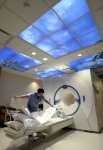
The manmade skyscape, called a SkyCeiling, is produced by Fairfield-based company called the Sky Factory. The circular SkyCeiling features a pale sliver of a moon hanging against a deep blue sky, tree branches speckled with bright green leaves and gauzy white clouds.
Mercy Therapeutic Radiology has three SkyCeilings, the first installed in late 2003. The hospital also invested in three virtual windows made by the Sky Factory, with landscapes that use a window as the point of reference.
Each virtual window costs $2,000 to $3,000. The ceiling murals cost from $3,000 to $13,000.
11:40 Posted in Emotional computing | Permalink | Comments (0) | Tags: Emotional technology
Jul 05, 2005
Accupix MP Glass MPG-230A HMD Video Glasses - Get Your Mobile Presence Experience
Wow. This is really cool stuff. The Accupix MP glass MPG-230A Video Glasses and portable player are maybe the best example of next-generation virtual reality systems. This technology enables the vision of "mobile presence": your body is in a physical space, but your mind is somewhere else. Imagine you're on the tube, bored and frustrated. Wou desperetely desire to escape from there, and experience five minute of peaceful relax. You have just to wear your portable immersive headset, and bon voyage.
There are many Positive applications that we can imagine using this technology, ranging from "traditional" virtual-reality based treatment to mobile telemedicine applications.
The system is also quite affordable (649$) as compared to traditional HMD.
If you want to know more, read the technical review by Ken Wold for I4U:
| Overview |
15:20 Posted in Wearable & mobile | Permalink | Comments (0) | Tags: Positive Technology, wearable







